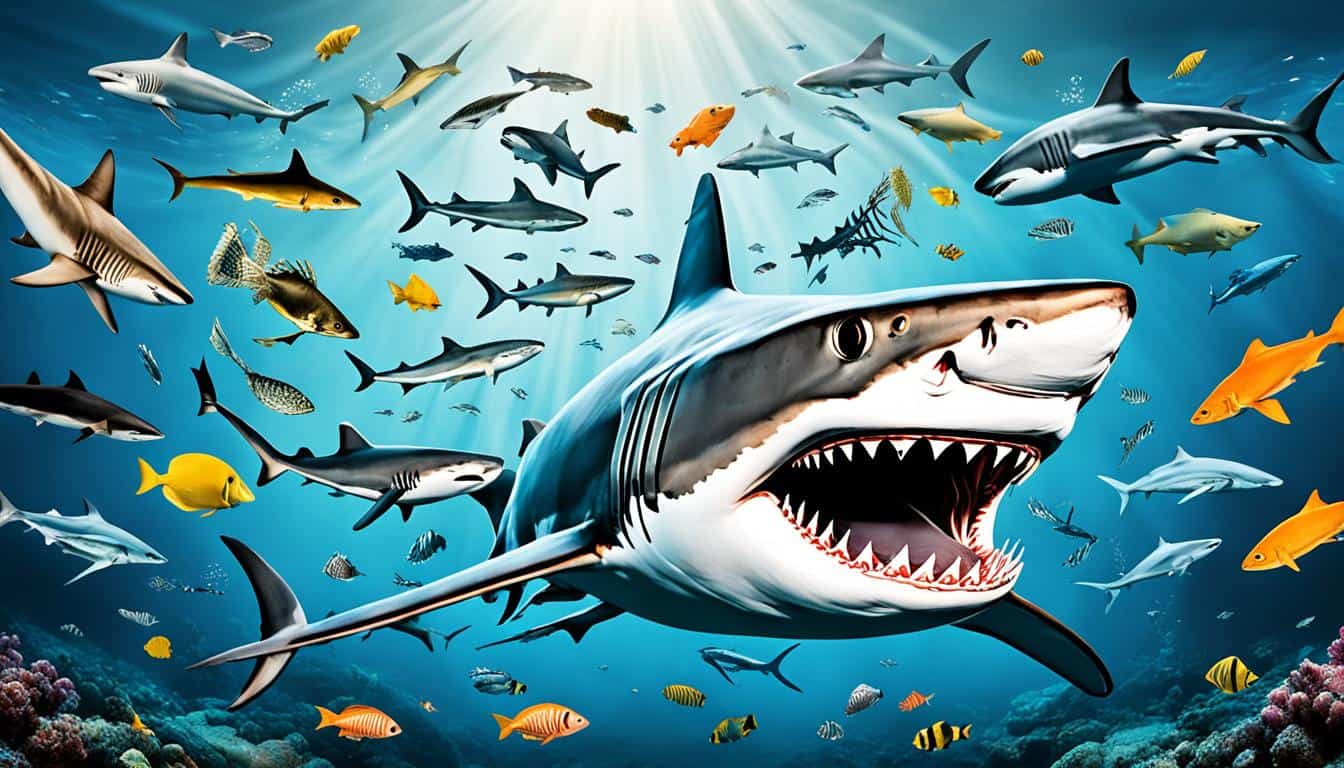Sharks are fascinating creatures that play a key role in the ocean. You might ask, what do sharks eat? Their diet varies greatly among species. They eat fish, mollusks, and even marine mammals. Knowing what they eat shows their importance in the ocean and the challenges they face today.
Some sharks, like the hammerhead, eat stingrays. Others, like the tiger shark, eat both live and dead prey. Exploring their diets helps us understand these amazing animals better. It also shows how important they are for the ocean’s health and diversity.
Understanding Shark Diet Diversity
Sharks have a wide variety of diets, influenced by their size, habitat, and role in the ocean. Their feeding habits show how they fit into the marine world. Let’s look at the different foods sharks eat and how their homes affect their diets.
Diverse Food Sources Across Species
Sharks are top predators in the sea, eating a variety of prey. Each shark species has its own diet, which can include:
- Great white sharks: They mainly eat seals and sea lions for their fat content.
- Tiger sharks: These sharks eat fish, seabirds, and even dead animals.
- Hammerhead sharks: They like to hunt schools of fish and stingrays.
- Whale sharks: These sharks filter-feed on plankton and small fish, making them unique.
Impact of Habitat on Shark Diet
Where sharks live affects what they eat. Sharks near the coast might eat fish and crustaceans. Those in deeper water might go after squid or bigger animals. Things like:
- Water temperature
- Oxygen levels
- Prey availability
These factors are key in shaping a shark’s diet. Sharks in rich waters often find plenty to eat, which helps them grow and survive. Knowing this helps us understand sharks better and their role in the ocean.
| Shark Species | Typical Prey | Habitat Preference |
|---|---|---|
| Great White Shark | Seals, Sea Lions | Coastal waters |
| Tiger Shark | Fish, Seabirds, Carrion | Tropical and temperate waters |
| Hammerhead Shark | Bony Fish, Stingrays | Continental shelves |
| Whale Shark | Plankton, Small Fish | Open ocean |
What Do Sharks Eat?
Sharks have different diets based on their species, size, and how they hunt. They have evolved over millions of years to be very efficient at finding and eating their food. This shows in their hunting skills and what they like to eat.
Common Prey for Various Shark Species
Sharks eat a wide variety of things, including:
- Fish
- Crustaceans
- Marine mammals
- Plankton
- Turtles
Tiger sharks eat almost anything they can find, from fish to turtles, and sometimes even objects that aren’t food. Great white sharks, on the other hand, mainly eat seals and sea lions because they can catch them easily.
Adaptations that Influence Shark Diet
Sharks have special features that help them eat better. These features include:
- Specialized teeth: Great whites have sharp teeth for tearing flesh. Whale sharks have blunt teeth for eating plankton.
- Unique feeding mechanisms: Nurse sharks use a suction method to get food from tight spots. This shows how sharks adapt to their food and environment.
These differences show how sharks have changed over time to fit their diets and environments. This helps them survive and thrive in the ocean.
Shark Feeding Habits: How Sharks Hunt
Sharks are top predators in the ocean, with fascinating ways of hunting. They use different strategies to catch their prey. Each shark species has its own way of hunting, based on its environment and body shape.
Predatory Techniques Utilized by Sharks
Sharks have many ways to catch their food. Some of these methods are:
- Ambush: The bull shark surprises its prey with stealth attacks.
- Speed Chases: The shortfin mako shark chases fast-moving prey with its speed.
- Circular Hunting: Tiger sharks circle their prey before making a surprise attack.
- Group Hunting: Some sharks hunt together during certain times of the year, making them more effective.
Role of Sensory Adaptations in Capturing Prey
Sharks’ hunting success comes from their amazing senses. These senses include:
- Acute Sense of Smell: Sharks can smell blood and other scents from far away.
- Electrosensory Systems: Sharks can feel the electrical signals from other sea creatures, helping them find hidden prey.
- Vision Adaptations: Many sharks see well in the dark, making them good hunters at night.

These senses help sharks find their way and catch prey with precision. Knowing about these skills shows how important sharks are in the ocean. They are very good at hunting.
Types of Food Sharks Consume
Sharks eat different foods based on their size and where they live. Big sharks like the great white and tiger sharks prefer to eat marine mammals. They need a lot of energy from their food to stay strong and active in the ocean.
Prey Preferences of Large Sharks versus Smaller Sharks
Smaller sharks, like the blacktip and nurse sharks, eat smaller prey. They feed on shrimp, small fish, and mollusks. Since they are smaller, they don’t need as much energy. This affects what they eat and how they hunt.
Importance of Nutrition in Shark Diet
Sharks need the right nutrition to live a healthy life. They eat about 1% to 10% of their body weight each week. How well they digest and store energy is key to their survival, especially in areas with little food.
The Greenland shark has special ways to save energy, helping it survive with less food. This shows how important it is for sharks to have a varied diet that meets their nutritional needs.
FAQ
What do sharks typically eat?
Sharks eat a wide variety of food, including fish, mollusks, crustaceans, marine mammals, and other sharks. What they eat depends on their type, size, and where they live.
How does the diet of different shark species vary?
Each shark species has its own preferred food based on its role in the ocean. For example, great white sharks mainly eat seals and sea lions. Smaller sharks might eat fish and squid.
What adaptations do sharks have for their eating habits?
Sharks have special teeth and ways of eating. Great white sharks have sharp teeth for meat. Whale sharks, on the other hand, have blunt teeth for eating plankton.
Do sharks hunt alone or in groups?
Most sharks hunt by themselves. But, some species hunt together during breeding or to catch more prey.
How do sharks locate their prey?
Sharks use their strong sense of smell and can feel electrical signals in the water to find food. These skills help them hunt effectively.
What is the importance of nutrition in a shark’s diet?
Sharks need to eat a lot to stay healthy. They eat about 1% to 10% of their body weight every week. Big sharks eat marine mammals for energy. Smaller sharks eat what they can find easily.
Can sharks adapt to changes in their food sources?
Yes, sharks can change what they eat based on what’s available in their area. They are very good at surviving as top predators.
How do environmental conditions impact shark diets?
The food and where sharks live affect what they eat. Sharks adjust their diet to match the food in their ocean home.







